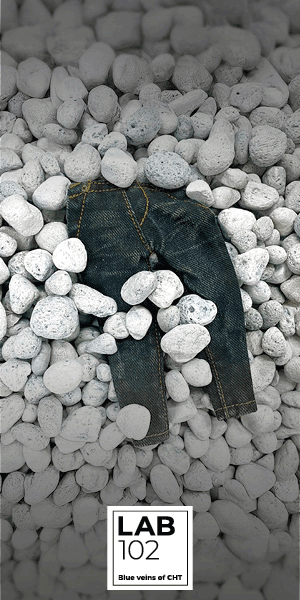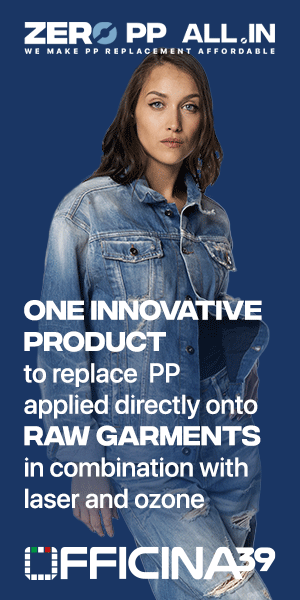Infinite colour

Dyeing is considered one of the most polluting processes in the textile industry, and growing garment waste is an issue the industry can no longer shrug off. When innovative chemicals companies and start-ups develop processes to recycle textile scraps into dyes or pigments, they create a circular solution for both.
It is striking how quickly waste has gone from being trash that must be disposed of, preferably destroyed, to a potential source of a new raw material. In a word, a resource. This vision is being applied to the vast variety of unused, unsold and end-of-life stuff the apparel industry usually discards.
Colour, and therefore dyes, are typically considered a hindrance to circularity. Some, fortunately, see it as a resource. Andrea Venier, CEO of Biella-based chemicals supplier Officina39, is one of these. The company has patented a method that “upcycles”, as he says, cellulosic textile waste into Recycrom, a coloured powder or pigment. His first research goes back to 2017, the first commercial product was launched with G-Star in 2019, and he says the concept really took off in 2022.
The process is almost entirely mechanical. “We take one kilo of waste cellulosic textiles and produce nearly one kilo of pigment in powder form. Our process generates very little waste, around 2 to 3%,” he says. Recycrom can thus boast having 100% recycled content, he insists. It can be used to dye both cellulosics and synthetics, and can also be used to print on polyester. Its main limitation is that the original colour of the fabric will generate a lighter shade once turned into Recycrom. “A red T-shirt will make a light red powder, a black one will be grey, and a dark blue will come out light blue,” he says. Like any dyestuff, powders can be blended to obtain different nuances, either at the beginning of the process, by mixing various colours of waste material, or once in pigment form. An item dyed with Recycrom can furthermore be ‘upcycled’ several times, and at each stage the shade will continue to lose intensity.
As Recycrom turns leftover textiles into a powder, it can offer a second life to lower grade waste that can not be recycled into yarns. The process begins with a sorting phase by colour, followed by shredding. This allows the company to use small pieces of fabric scraps from garment manufacturing facilities. Mr Venier says that cutting and sewing operations generate 6% offcuts that, if not suitable for recycling into yarn, are perfect for Recycrom and could even eliminate the need to shred fabrics into smaller pieces, speeding up the process. The original dye can be reactive or sulphur. “We have not found any particular difference in reactive- or sulphur-dyed fabrics,” he says.
Several patents cover Officina39’s Recycrom: the waste-to-powder process, the machinery, and the binder between the micronised powder and the textile. “When a Recycrom dyed product is examined by a lab, it will find fibres, not dyestuff,” he says. The powder, which is a pigment, is insoluble, he adds.
Brands looking to develop Recycrom-dyed products have two options, he continues. “They can send us their factory offcuts, their pre- and post-consumer waste, and we can upcycle it to dye new products. Or, they can use waste we have collected from our partners, in Italy, or from companies such as Reverse Resources.” All pre-consumer waste must however come from an Oekotex-certified factory. He says that post-consumer products could be recycled, but it is not known how they were manufactured and this could be problematic. In a project with German collector and sorter ICO, Officina39 conducted trials, testing random batches, and did not find any toxic chemistry. But Mr Venier is not pushing for post-consumer waste, preferring to play it safe by focusing on post-industrial materials of known provenance.
New sources of recycled dyes
In 2014, Archroma, a global specialty chemicals supplier, introduced EarthColors, a range of dyestuffs partially made from agroindustry waste. The company headquartered in Switzerland has just launched a new family of dyes made from pre- and post-consumer leftover textiles, in cotton and/or nylon, which it intends to call FiberColors. They do not need to be sorted by colour, and make up more than 50% of the dyestuff. This allows the company to accept a wide array of post-industrial and post-consumer waste, and encompasses even residual dust from sorting facilities, Nuria Estape, Archroma’s head of marketing for textile specialties, tells Inside Denim.
It remains that the dyestuff’s content is only partially recycled. “For now, given the existing technical boundaries of using recycled fibres as a raw material, we are already very proud to be able to replace between 50% and 100% of the petroleum-based dyestuff,” she says. Archroma complements the remaining portion with conventional chemistry, which she says allows the company to combine the best of both worlds: “a recycled material with a dyestuff that has affinity for cellulosic fibres, good colour consistency and good fastness.” For now, the patent-pending FiberColor technology is being offered in a palette of five shades: brown, olive, burgundy, slate and dark grey.
Archroma is looking to partner with brands that seek circular solutions and having access to sorted and shredded pre- and post-consumer waste. Denim is a perfect candidate, says Ms Estape; FiberColors are sulphur-based dyestuffs that are ideally suited to create wash-down effects and denim fabrics are most often at least 95% cotton, meaning they can be feedstock for the recycled dye.
The difference between Recycrom and FiberColors is that Archroma’s technology is indifferent to the original colour of the material, and the resulting sulphur liquid dyestuff does not require the addition of binders. Officina39, as seen, transforms the original colour into a lighter shade, using a mechanical process, to produce a 100% recycled pigment. Archroma does not specify how it turns old clothes into components for dyestuff, but it does add in a dose of conventional petrochemicals.
Officina39 does not rule out the possibility of combining Recycrom with a conventional petrochemical dye to achieve a darker shade, or a specific nuance. “Some brands, such as Pangaia, want a fully circular solution and will not settle for less than 100% Recycrom,” says Mr Venier. “But others may want a dark shade, a true black for instance, and will decide to use 70 or 80% Recycrom and complement it with conventional dyestuffs to achieve the desired shade.”
He sees this as a way to support commercial brands seeking to dye their ranges with Recycrom. Fast fashion retailers looking to develop more sustainable products are knocking on Officina39’s door. “We can evolve with brands like Pangaia, but we would have a much bigger impact with high street brands and retailers,” he points out. Sales of Recycrom have been picking up. Though a small part of the company’s business, its sales tripled in 2022 compared to 2021 and Mr Venier expects sales to double in 2023. “In two years time, we may be able to increase sales by a factor of six,” he says. Companies looking to use Recycrom are moving away from one-shot capsule collections to making entire product ranges, carried over from season to season, he says, citing Tommy Hilfiger and Italian fast fashion retailer OVS. “Before brands would use Recycrom one season for its story-telling appeal. In the past three years, we have seen a big shift with brands developing longer term projects with us.”
What’s next?
A number of start-ups are also looking to recycle dyes from waste textiles. The thinking of DyeRecycle, in the UK, and Induo, in France, is that unused fabric scraps and clothing should be exploited to the fullest. At a conference at Première Vision last February, Induo co-founder Pauline Guesné presented the company’s Greencose recycling process for cellulose and polyester textile waste. One of the phases of its technology involves the removal of colour, which, she suggested, could itself be recycled. Work on that part of the young company’s projects may be a long way down, as it is still at lab scale.
British start-up DyeRecycle is taking the opposite path. The technology it is currently working on “selectively extracts dyes from waste fibres and transfers the dyes to a new fabric” using, it says, “non-hazardous liquids”. The decoloured fabric will then be easier to recycle into a fibre and dyed anew. Initial tests at DyeRecycle appear to focus on pre-consumer waste, before it begins to tackle discarded post-consumer clothing.
The Hong Kong research institute of textiles and apparel (HKRITA) has developed and patented a decolourisation process that uses high temperature water to “drive disperse dyes out of polyester and indigo dye out of denim cotton,” says senior research manager Dr Alex Chan. “Generally speaking,” he adds, “the reuse of dyes is possible.” But the colours may mix, “making it difficult to control the hue of the re-dyed fabric.” This solution may be more suited to homogenising end-of-life textiles and apparel feedstocks for mechanical recycling into fibre. It is one of the many scenarios that sees in any form of discarded apparel, the building blocks, and resources, for new products, be they fibres or dyes.
Circle Book, an exercise in circular design fronted by Italian design agency Meidea, seeks to encourage more sustainable denims. Officina39 has been involved in the programme since its beginnings. Shown here, an item from Circle Book #3.
Photo: Meidea srl













